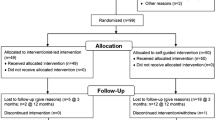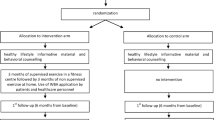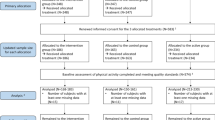Abstract
The effectiveness of different programs of physical activity outside randomized studies is difficult to determine. We carried out an audit in two different units where either a supervised physical activity (PA) program or a self-selected PA program was in use in individuals with type 2 diabetes or obesity. The supervised PA cohort (n = 101) received progressive gym training (120 min, twice a week for 13 weeks) by a dedicated team, with nutritional counseling during resting periods. The self-selected PA cohort (n = 69) was enrolled in a 13-week cognitive-behavioral program (120 min/week, in groups of 12–15 individuals), chaired by an expert team. Body weight and physical fitness (6-min walk test) were measured at baseline and after 6 and 12 months. Outcome measures were attrition, weight loss ≥10 % initial body weight, 10 % increase in 6-min walk test; their association with a PA program was tested by logistic regression analysis. Attrition rate was lower in the supervised PA group (28 vs. 45 % than in the self-selected cohort, P = 0.023). After adjustment for confounders, the supervised PA program was associated with a lower risk of attrition at 1 year (odds ratio 0.45; 95 % confidence interval, 0.21–0.98) at logistic regression analysis. Body weight similarly decreased in both groups (more rapidly in the supervised PA cohort); also physical fitness improved in a similar way, and no differences in achieved targets of body weight (supervised, 31 %; self-selected, 18 %; P = 0.118) or fitness (supervised, 62 %; self-selected, 49 %; P = 0.312) were demonstrated. Different PA programs produce very similar health benefits, but an initially supervised program has lower attrition rates, which might translate into better outcomes in the long term.


Similar content being viewed by others
Abbreviations
- BMI:
-
Body mass index
- CI:
-
Confidence interval
- OR:
-
Odds ratio
- PA:
-
Physical activity
References
Pagano E, De Rosa M, Rossi E, Cinconze E, Marchesini G, Miccoli R, Vaccaro O, Bonora E, Bruno G, the ARNO Diabetes Observatory (2016) The relative burden of diabetes complications on healthcare costs: the population-based ARNO Diabetes Observatory, Italy. Nutr Metab Cardiovasc Dis (ePub May 24). doi:10.1016/j.numecd.2016.05.002
Atlantis E, Barnes EH, Ball K (2008) Weight status and perception barriers to healthy physical activity and diet behavior. Int J Obes (Lond) 32(2):343–352. doi:10.1038/sj.ijo.0803707
Goode RW, Ye L, Sereika SM, Zheng Y, Mattos M, Acharya SD, Ewing LJ, Danford C, Hu L, Imes CC, Chasens E, Osier N, Mancino J, Burke LE (2016) Socio-demographic, anthropometric, and psychosocial predictors of attrition across behavioral weight-loss trials. Eat Behav 20:27–33. doi:10.1016/j.eatbeh.2015.11.009
Sherwood NE, Jeffery RW (2000) The behavioral determinants of exercise: implications for physical activity interventions. Annu Rev Nutr 20:21–44. doi:10.1146/annurev.nutr.20.1.21-20/1/21
Centis E, Moscatiello S, Bugianesi E, Bellentani S, Fracanzani AL, Calugi S, Petta S, Dalle Grave R, Marchesini G (2013) Stage of change and motivation to healthier lifestyle in non-alcoholic fatty liver disease. J Hepatol 58(4):771–777. doi:10.1016/j.jhep.2012.11.031
Centis E, Trento M, Dei Cas A, Pontiroli AE, De Feo P, Bruno A, Sasdelli AS, Arturi F, Strollo F, Vigili De’ Kreutzenberg S, Invitti C, Di Bonito P, Di Mauro M, Pugliese G, Molteni A, Marchesini G (2014) Stage of change and motivation to healthy diet and habitual physical activity in type 2 diabetes. Acta Diabetol 51(4):559–566. doi:10.1007/s00592-013-0551-1
Melchionda N, Forlani G, La Rovere L, Argnani P, Trevisani F, Zocchi D, Savorani G, Covezzoli A, De Rosa M, Marchesini G (2006) Disease management of the metabolic syndrome in a community. Study design and process analysis on baseline data. Metab Syndr Relat Disord 4:7–16. doi:10.1089/met.2006.4.7
Ekkekakis P, Lind E (2006) Exercise does not feel the same when you are overweight: the impact of self-selected and imposed intensity on affect and exertion. Int J Obes (Lond) 30(4):652–660. doi:10.1038/sj.ijo.0803052
Montesi L, Caselli C, Centis E, Nuccitelli C, Moscatiello S, Suppini A, Marchesini G (2014) Physical activity support or weight loss counseling for nonalcoholic fatty liver disease? World J Gastroenterol 20(29):10128–10136. doi:10.3748/wjg.v20.i29.10128
Dalle Grave R, Melchionda N, Calugi S, Centis E, Tufano A, Fatati G, Fusco MA, Marchesini G (2005) Continuous care in the treatment of obesity. An observational multicentre study. J Intern Med. 258(3):265–273. doi:10.1111/j.1365-2796.2005.01524.x
Perri MG, Sears SF Jr, Clark JE (1993) Strategies for improving maintenance of weight loss. Toward a continuous care model of obesity management. Diabetes Care 16(1):200–209
Dalle Grave R, Calugi S, Centis E, El Ghoch M, Marchesini G (2011) Cognitive-behavioral strategies to increase the adherence to exercise in the management of obesity. J Obes 2011:348293. doi:10.1155/2011/348293
Fabricatore AN (2007) Behavior therapy and cognitive-behavioral therapy of obesity: is there a difference? J Am Diet Assoc 107(1):92–99. doi:10.1016/j.jada.2006.10.005
Perri MG, Martin AD, Leermakers EA, Sears SF, Notelovitz M (1997) Effects of group- versus home-based exercise in the treatment of obesity. J Consult Clin Psychol 65(2):278–285
Ford ES, Herman WH (1995) Leisure-time physical activity patterns in the US diabetic population. Findings from the 1990 National Health Interview Survey-Health Promotion and Disease Prevention Supplement. Diabetes Care 18(1):27–33
Mangeri F, Montesi L, Forlani G, Dalle Grave R, Marchesini G (2014) A standard ballroom and Latin dance program to improve fitness and adherence to physical activity in individuals with type 2 diabetes and in obesity. Diabetol Metab Syndr 6:74. doi:10.1186/1758-5996-6-74
Balducci S, Zanuso S, Nicolucci A, De Feo P, Cavallo S, Cardelli P, Fallucca S, Alessi E, Fallucca F, Pugliese G (2010) Effect of an intensive exercise intervention strategy on modifiable cardiovascular risk factors in subjects with type 2 diabetes mellitus: a randomized controlled trial: the Italian Diabetes and Exercise Study (IDES). Arch Intern Med 170(20):1794–1803. doi:10.1001/archinternmed.2010.380
Wadden TA, West DS, Delahanty L, Jakicic J, Rejeski J, Williamson D, Berkowitz RI, Kelley DE, Tomchee C, Hill JO, Kumanyika S (2006) The Look AHEAD study: a description of the lifestyle intervention and the evidence supporting it. Obesity (Silver Spring, Md.) 14(5):737–752. doi:10.1038/oby.2006.84
Miller WR, Rollnick S (2002) Motivational interviewing, 2nd edn. The Guilford Press, New York
Alberti KG, Eckel RH, Grundy SM, Zimmet PZ, Cleeman JI, Donato KA, Fruchart JC, James WP, Loria CM, Smith SC Jr (2009) Harmonizing the metabolic syndrome: a joint interim statement of the International Diabetes Federation task force on epidemiology and prevention; National Heart, Lung, and Blood Institute; American Heart Association; World Heart Federation; International Atherosclerosis Society; and International Association for the Study of Obesity. Circulation 120(16):1640–1645. doi:10.1161/CIRCULATIONAHA.109.192644
Forlani G, Lorusso C, Moscatiello S, Ridolfi V, Melchionda N, Di Domizio S, Marchesini G (2009) Are behavioural approaches feasible and effective in the treatment of type 2 diabetes? A propensity score analysis vs. prescriptive diet. Nutr Metab Cardiovasc Dis 19(5):313–320. doi:10.1016/j.numecd.2008.06.004
Brownell KD (1991) The LEARN program for weight control. Am Health, Dallas
Guyatt GH, Thompson PJ, Berman LB, Sullivan MJ, Townsend M, Jones NL, Pugsley SO (1985) How should we measure function in patients with chronic heart and lung disease? J Chronic Dis 38(6):517–524
Matthews DR, Hosker JP, Rudenski AS, Naylor BA, Treacher DF, Turner RC (1985) Homeostasis model assessment: insulin resistance and beta-cell function from fasting plasma glucose and insulin concentrations in man. Diabetologia 28(7):412–419
Bennett GA, Jones SE (1986) Dropping out of treatment for obesity. J Psychosom Res 30(5):567–573
Dalle Grave R, Calugi S, Molinari E, Petroni ML, Bondi M, Compare A, Marchesini G, Quovadis Study Group (2005) Weight loss expectations in obese patients and treatment attrition: an observational multicenter study. Obes Res 13(11):1961–1969. doi:10.1038/oby.2005.241
Inelmen EM, Toffanello ED, Enzi G, Gasparini G, Miotto F, Sergi G, Busetto L (2005) Predictors of drop-out in overweight and obese outpatients. Int J Obes Relat Metab Disord 29(1):122–128. doi:10.1038/sj.ijo.0802846
Moroshko I, Brennan L, O’Brien P (2011) Predictors of dropout in weight loss interventions: a systematic review of the literature. Obes Rev 12(11):912–934. doi:10.1111/j.1467-789X.2011.00915.x
National Institutes of Health (1998) Clinical guidelines on the identification, evaluation, and treatment of overweight and obesity in adults-the evidence report. Obes Res 6(Suppl 2):51S–209S
Wing RR, Hill JO (2001) Successful weight loss maintenance. Annu Rev Nutr 21:323–341. doi:10.1146/annurev.nutr.21.1.323-21/1/323
Jakicic JM, Marcus BH, Gallagher KI, Napolitano M, Lang W (2003) Effect of exercise duration and intensity on weight loss in overweight, sedentary women: a randomized trial. JAMA 290(10):1323–1330. doi:10.1001/jama.290.10.1323
Jakicic JM, Clark K, Coleman E, Donnelly JE, Foreyt J, Melanson E, Volek J, Volpe SL (2001) American College of Sports Medicine position stand. Appropriate intervention strategies for weight loss and prevention of weight regain for adults. Med Sci Sports Exerc 33(12):2145–2156
Dalle Grave R, Calugi S, Centis E, Marzocchi R, El Ghoch M, Marchesini G (2010) Lifestyle modification in the management of metabolic syndrome: achievements and challenges. Diabetes Metab Syndr Obes 3:1–13. doi:10.2147/DMSOTT.S13860
Foster-Schubert KE, Alfano CM, Duggan CR, Xiao L, Campbell KL, Kong A, Bain CE, Wang CY, Blackburn GL, McTiernan A (2012) Effect of diet and exercise, alone or combined, on weight and body composition in overweight-to-obese postmenopausal women. Obesity (Silver Spring) 20(8):1628–1638. doi:10.1038/oby.2011.76
Villareal DT, Chode S, Parimi N, Sinacore DR, Hilton T, Armamento-Villareal R, Napoli N, Qualls C, Shah K (2011) Weight loss, exercise, or both and physical function in obese older adults. N Engl J Med 364(13):1218–1229. doi:10.1056/NEJMoa1008234
Dalle Grave R, Calugi S, Marchesini G (2014) The influence of cognitive factors in the treatment of obesity: lessons from the QUOVADIS study. Behav Res Ther 63C:157–161. doi:10.1016/j.brat.2014.10.004
Author information
Authors and Affiliations
Corresponding author
Ethics declarations
Conflict of interest
None in relation to the material presented in this report.
Statement of human and animal rights
All procedures performed in this study involving human participants were in accordance with the ethical standards of the institutional and/or national research committees and with the 1964 Helsinki declaration and its later amendments or comparable ethical standards.
Informed consent
For this type of study (clinical audit) formal consent is not required.
Rights and permissions
About this article
Cite this article
Mazzuca, P., Montesi, L., Mazzoni, G. et al. Supervised vs. self-selected physical activity for individuals with diabetes and obesity: the Lifestyle Gym program. Intern Emerg Med 12, 45–52 (2017). https://doi.org/10.1007/s11739-016-1506-7
Received:
Accepted:
Published:
Issue Date:
DOI: https://doi.org/10.1007/s11739-016-1506-7




